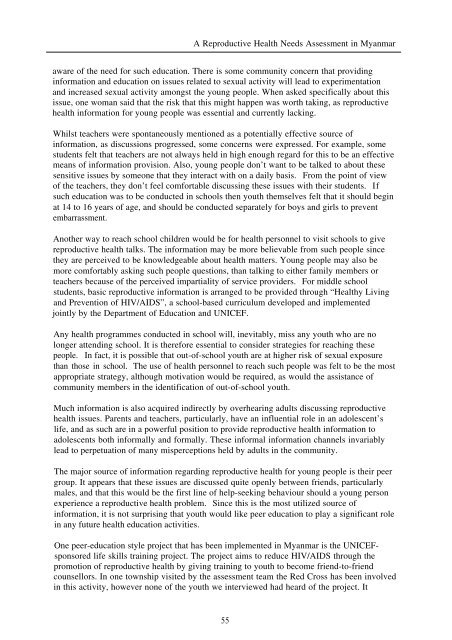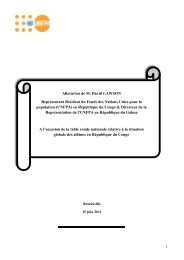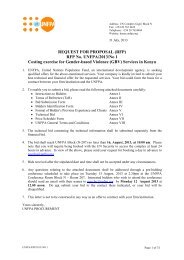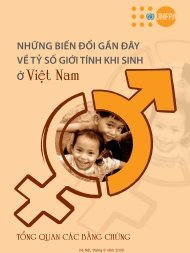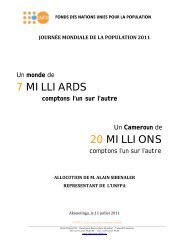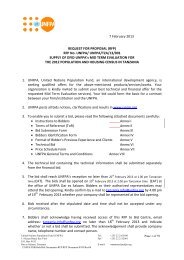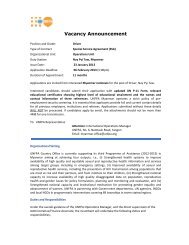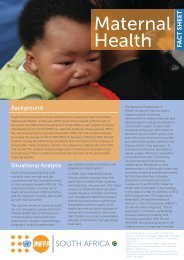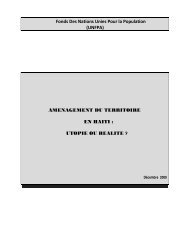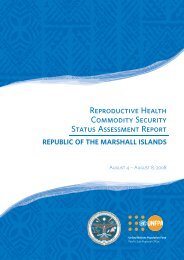A reproductive health needs assessment in Myanmar
A reproductive health needs assessment in Myanmar
A reproductive health needs assessment in Myanmar
You also want an ePaper? Increase the reach of your titles
YUMPU automatically turns print PDFs into web optimized ePapers that Google loves.
A Reproductive Health Needs Assessment <strong>in</strong> <strong>Myanmar</strong><br />
aware of the need for such education. There is some community concern that provid<strong>in</strong>g<br />
<strong>in</strong>formation and education on issues related to sexual activity will lead to experimentation<br />
and <strong>in</strong>creased sexual activity amongst the young people. When asked specifically about this<br />
issue, one woman said that the risk that this might happen was worth tak<strong>in</strong>g, as <strong>reproductive</strong><br />
<strong>health</strong> <strong>in</strong>formation for young people was essential and currently lack<strong>in</strong>g.<br />
Whilst teachers were spontaneously mentioned as a potentially effective source of<br />
<strong>in</strong>formation, as discussions progressed, some concerns were expressed. For example, some<br />
students felt that teachers are not always held <strong>in</strong> high enough regard for this to be an effective<br />
means of <strong>in</strong>formation provision. Also, young people don’t want to be talked to about these<br />
sensitive issues by someone that they <strong>in</strong>teract with on a daily basis. From the po<strong>in</strong>t of view<br />
of the teachers, they don’t feel comfortable discuss<strong>in</strong>g these issues with their students. If<br />
such education was to be conducted <strong>in</strong> schools then youth themselves felt that it should beg<strong>in</strong><br />
at 14 to 16 years of age, and should be conducted separately for boys and girls to prevent<br />
embarrassment.<br />
Another way to reach school children would be for <strong>health</strong> personnel to visit schools to give<br />
<strong>reproductive</strong> <strong>health</strong> talks. The <strong>in</strong>formation may be more believable from such people s<strong>in</strong>ce<br />
they are perceived to be knowledgeable about <strong>health</strong> matters. Young people may also be<br />
more comfortably ask<strong>in</strong>g such people questions, than talk<strong>in</strong>g to either family members or<br />
teachers because of the perceived impartiality of service providers. For middle school<br />
students, basic <strong>reproductive</strong> <strong>in</strong>formation is arranged to be provided through “Healthy Liv<strong>in</strong>g<br />
and Prevention of HIV/AIDS”, a school-based curriculum developed and implemented<br />
jo<strong>in</strong>tly by the Department of Education and UNICEF.<br />
Any <strong>health</strong> programmes conducted <strong>in</strong> school will, <strong>in</strong>evitably, miss any youth who are no<br />
longer attend<strong>in</strong>g school. It is therefore essential to consider strategies for reach<strong>in</strong>g these<br />
people. In fact, it is possible that out-of-school youth are at higher risk of sexual exposure<br />
than those <strong>in</strong> school. The use of <strong>health</strong> personnel to reach such people was felt to be the most<br />
appropriate strategy, although motivation would be required, as would the assistance of<br />
community members <strong>in</strong> the identification of out-of-school youth.<br />
Much <strong>in</strong>formation is also acquired <strong>in</strong>directly by overhear<strong>in</strong>g adults discuss<strong>in</strong>g <strong>reproductive</strong><br />
<strong>health</strong> issues. Parents and teachers, particularly, have an <strong>in</strong>fluential role <strong>in</strong> an adolescent’s<br />
life, and as such are <strong>in</strong> a powerful position to provide <strong>reproductive</strong> <strong>health</strong> <strong>in</strong>formation to<br />
adolescents both <strong>in</strong>formally and formally. These <strong>in</strong>formal <strong>in</strong>formation channels <strong>in</strong>variably<br />
lead to perpetuation of many misperceptions held by adults <strong>in</strong> the community.<br />
The major source of <strong>in</strong>formation regard<strong>in</strong>g <strong>reproductive</strong> <strong>health</strong> for young people is their peer<br />
group. It appears that these issues are discussed quite openly between friends, particularly<br />
males, and that this would be the first l<strong>in</strong>e of help-seek<strong>in</strong>g behaviour should a young person<br />
experience a <strong>reproductive</strong> <strong>health</strong> problem. S<strong>in</strong>ce this is the most utilized source of<br />
<strong>in</strong>formation, it is not surpris<strong>in</strong>g that youth would like peer education to play a significant role<br />
<strong>in</strong> any future <strong>health</strong> education activities.<br />
One peer-education style project that has been implemented <strong>in</strong> <strong>Myanmar</strong> is the UNICEFsponsored<br />
life skills tra<strong>in</strong><strong>in</strong>g project. The project aims to reduce HIV/AIDS through the<br />
promotion of <strong>reproductive</strong> <strong>health</strong> by giv<strong>in</strong>g tra<strong>in</strong><strong>in</strong>g to youth to become friend-to-friend<br />
counsellors. In one township visited by the <strong>assessment</strong> team the Red Cross has been <strong>in</strong>volved<br />
<strong>in</strong> this activity, however none of the youth we <strong>in</strong>terviewed had heard of the project. It<br />
55


